#continuous testing in devops
Explore tagged Tumblr posts
Text
AI in DevSecOps: Revolutionizing Security Testing and Code Analysis

DevSecOps, short for Development, Security, and Operations, is an approach that integrates security practices within the DevOps workflow. You can think of it as an extra step necessary for integrating security. Before, software development focused on speed and efficiency, often delaying security to the final stages.
However, the rise in cyber threats has made it essential to integrate security into every phase of the software lifecycle. This evolution gave rise to DevSecOps, ensuring that security is not an afterthought but a shared responsibility across teams.
From DevOps to DevSecOps: The Main Goal
The shift from DevOps to DevSecOps emphasizes applying security into continuous integration and delivery (CI/CD) pipelines. The main goal of DevSecOps is to build secure applications by automating security checks. This approach helps in fostering a culture where developers, operations teams, and security experts collaborate seamlessly.
How is AI Reshaping the Security Testing & Code Analysis Industry?
Artificial intelligence and generative AI are transforming the landscape of security testing and code analysis by enhancing precision, speed, and scalability. Before AI took over, manual code reviews and testing were time-consuming and prone to errors. AI-driven solutions, however, automate these processes, enabling real-time vulnerability detection and smarter decision-making.
Let’s look at how AI does that in detail:
AI models analyze code repositories to identify known and unknown vulnerabilities with higher accuracy.
Machine learning algorithms predict potential attack vectors and their impact on applications.
AI tools simulate attacks to assess application resilience, saving time and effort compared to manual testing.
AI ensures code adheres to security and performance standards by analyzing patterns and dependencies.
As you can imagine, there have been several benefits of this:
Reducing False Positives: AI algorithms improve accuracy in identifying real threats.
Accelerating Scans: Traditional methods could take hours, but AI-powered tools perform security scans in minutes.
Self-Learning Capabilities: AI systems evolve based on new data, adapting to emerging threats.
Now that we know about the benefits AI has, let’s look at some challenges AI could pose in security testing & code analysis:
AI systems require large datasets for training, which can expose sensitive information if not properly secured. This could cause disastrous data leaks.
AI models trained on incomplete or biased data may lead to blind spots and errors.
While AI automates many processes, over-reliance can result in missed threats that require human intuition to detect.
Cybercriminals are leveraging AI to create advanced malware that can bypass traditional security measures, posing a new level of risk.
Now that we know the current scenario, let’s look at how AI in DevSecOps will look like in the future:
The Future of AI in DevSecOps
AI’s role in DevSecOps will expand with emerging trends as:
Advanced algorithms will proactively search for threats across networks, to prevent attacks.
Future systems will use AI to detect vulnerabilities and automatically patch them without human intervention.
AI will monitor user and system behavior to identify anomalies, enhancing the detection of unusual activities.
Integrated AI platforms will facilitate seamless communication between development, operations, and security teams for faster decision-making.
AI is revolutionizing DevSecOps by making security testing and code analysis smarter, faster, and more effective. While challenges like data leaks and algorithm bias exist, its potential is much more than the risks it poses.
To learn how our AI-driven solutions can elevate your DevSecOps practices, contact us at Nitor Infotech.
#continuous integration#software development#software testing#engineering devops#applications development#security testing#application security scanning#software services#nitorinfotech#blog#ascendion#gen ai
0 notes
Text
#agile development#backend development#conclusion#continuous deployment#continuous integration#deployment#designing#DevOps#DevOps engineer#documentation#FAQs#frontend development#introduction#lean development#maintenance#product manager#Programming Languages#quality assurance engineer#requirement analysis#scrum master#software development#software development jobs#software development life cycle#software engineer#test-driven development#testing#types of software development#user documentation#what is software development
0 notes
Text
Importance of Continuous Testing in DevOps

DevOps – An Overview:
DevOps, a combination of development and operations, is a set of practices that aims to shorten the system development life cycle and deliver high-quality software continuously. It focuses on collaboration, automation, and continuous feedback among developers and IT professionals. In a DevOps environment, Continuous Integration (CI) and Continuous Deployment (CD) are crucial components, and they rely heavily on another essential aspect - Continuous Testing Services.
Importance of Continuous Testing:
Continuous Testing plays a pivotal role in the success of DevOps practices. It involves automated testing throughout the development pipeline, ensuring that every code change is thoroughly tested before deployment. Here are some key initiatives from different functions of software development that highlight the significance of Continuous Testing:
Accelerated Development Cycles: Continuous Testing enables rapid development cycles by automating the testing process. With each code change, automated tests are executed, providing rapid feedback to developers. This quick feedback loop allows for early detection of bugs, reducing the time and effort required for debugging.
Enhanced Code Quality: Continuous Testing ensures that code changes do not introduce new defects or issues. Automated testing guarantees that the software meets predefined quality standards, leading to higher code quality. This, in turn, reduces the likelihood of critical issues surfacing in production.
Reduced Time to Market: The seamless integration of testing into the development pipeline minimizes delays caused by manual testing processes. Continuous Testing accelerates the delivery of software, enabling organizations to bring new features and updates to the market faster.
Increased Collaboration: DevOps emphasizes collaboration between development, testing, and operations teams. Continuous Testing fosters communication and collaboration by providing a common framework for testing. This shared approach encourages a collective responsibility for the quality of the software.
Improved Risk Management: Continuous Testing helps identify and address potential risks early in the development process. By automating the testing of critical functionalities and edge cases, teams can mitigate the risk of system failures and unexpected issues in production.
Conclusion:
In the dynamic landscape of software development, where agility and reliability are paramount, Continuous Testing stands as a linchpin in the DevOps framework. It aligns with the principles of collaboration, automation, and feedback, ensuring that software development and deployment are seamless, efficient, and error-free. As organizations increasingly adopt DevOps practices, recognizing the importance of Continuous Testing becomes imperative for achieving faster time-to-market, enhanced code quality, and overall business success.
Discover invaluable insights and best practices for implementing The Best DevOps Strategy for Continuous Testing in 2024! in our comprehensive blog.
1 note
·
View note
Text
Automation Testing Insights: Transforming Testing
The global automation testing market size is expected to reach USD 92.45 billion by 2030. Prominent technological advancement in artificial intelligence (AI) and machine learning (ML) is propelling the demand for the market. Mobile application usage is growing across various end-user industries, and smartphone penetration is rising, opening an attractive potential for market expansion. Furthermore, there is a rising demand for automation testing as web-based applications have developed significantly and new software technologies have emerged. The market is growing rapidly due to the increasing usage of ML and AI for advanced analytics and continuous testing across DevOps and DevSecOps areas.
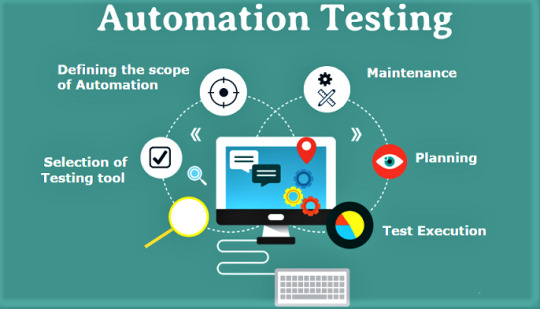
Automation Testing Market Report Highlights
The services segment dominated the market and accounted for over 56% of the global revenue owing to rapid advancements in implementation services, which make it easier to include automation into a functioning infrastructure for software testing
With the aid of this service, automation is integrated into an existing software automation testing setup
The large enterprises segment held the largest revenue share in 2022 as it helps improve efficiency, reduce manual effort, increase test coverage, and ensure the quality of software applications
The BFSI segment is estimated to have significant growth over the forecast period; adopting digitalization in the BFSI sector creates a significant demand for application software automation testing
Gain deeper insights on the market and receive your free copy with TOC now @: Automation Testing Market Report
The emerging use of RPA to automate time-consuming, error-prone manual processes are just a few instances of the usage of AI & ML in automation testing. Moreover, a bot uses the page’s numerous links and web forms to systematically explore through an online application when web crawling or spidering. This is a new use for AI and ML in automation testing. This approach is typically used for indexing online browsing. It may be improved further to perform reverse engineering on an application being tested and automatically find Test Cases. Emerging automation testing tools are significantly fueling market growth.
For instance, Testcraft, a codeless Selenium test automation platform for regression and continuous testing, as well as monitoring of web applications, is gaining traction among users. Their revolutionary AI tech removes maintenance time and cost, as it certainly affects changes in the app. Similarly, Applitools Eyes, Testim, and Test.ai are more automation testing tools propelling the market growth. Furthermore, mergers and acquisitions by other key players are propelling market growth. For instance, in 2022, to improve the user experience on 5G smartphones, Key sight introduced AI-driven and automated testing. Automation and AI enable mobile service providers and app developers to more swiftly evaluate how smartphone users engage with native apps in the real world.
#Automation Testing#Quality Assurance#Software Testing#Test Automation#Continuous Testing#Test Automation Framework#DevOps Testing#Selenium#Test Automation Tools#Performance Testing#Regression Testing#Agile Testing#UIAutomation#Test Scripting#Test Automation Engineer#Codeless Automation#Automation Strategy#CI/CDTesting#Test Automation Best Practices
0 notes
Text
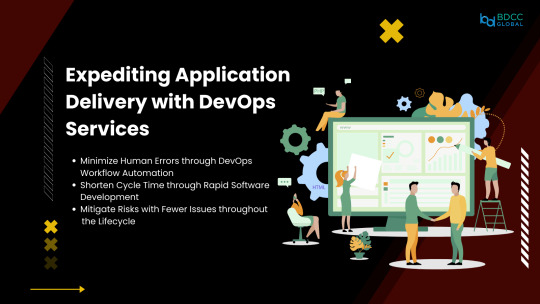
Accelerate your application delivery with DevOps services! 🚀💻
From continuous integration to automated testing, our expert developers are here to help you streamline your software development process and get your apps to market faster.
#applications#devops#continuous integration#automation testing#software development#apps#expert developers#delivery
1 note
·
View note
Text
How does AI contribute to the automation of software testing?
AI-Based Testing Services

In today’s modern rapid growing software development competitive market, ensuring and assuming quality while keeping up with fast release cycles is challenging and a vital part. That’s where AI-Based Testing comes into play and role. Artificial Intelligence - Ai is changing the software testing and checking process by making it a faster, smarter, and more accurate option to go for.
Smart Test Case Generation:
AI can automatically & on its own analyze past test results, user behavior, and application logic to generate relevant test cases with its implementation. This reduces the burden on QA teams, saves time, and assures that the key user and scenarios are always covered—something manual processes might overlook and forget.
Faster Bug Detection and Resolution:
AI-Based Testing leverages the machine learning algorithms to detect the defects more efficiently by identifying the code patterns and anomalies in the code behavior and structure. This proactive approach helps and assists the testers to catch the bugs as early as possible in the development cycle, improving product quality and reducing the cost of fixes.
Improved Test Maintenance:
Even a small or minor UI change can break or last the multiple test scripts in traditional automation with its adaptation. The AI models can adapt to these changes, self-heal broken scripts, and update them automatically. This makes test maintenance less time-consuming and more reliable.
Enhanced Test Coverage:
AI assures that broader test coverage and areas are covered by simulating the realtime-user interactions and analyzing vast present datasets into the scenario. It aids to identify the edge cases and potential issues that might not be obvious to human testers. As a result, AI-based testing significantly reduces the risk of bugs in production.
Predictive Analytics for Risk Management:
AI tools and its features can analyze the historical testing data to predict areas of the application or product crafted that are more likely to fail. This insight helps the teams to prioritize their testing efforts, optimize resources, and make better decisions throughout the development lifecycle.
Seamless Integration with Agile and DevOps:
AI-powered testing tools are built to support continuous testing environments. They integrate seamlessly with CI/CD pipelines, enabling faster feedback, quick deployment, and improved collaboration between development and QA teams.
Top technology providers like Suma Soft, IBM, Cyntexa, and Cignex lead the way in AI-Based Testing solutions. They offer and assist with customized services that help the businesses to automate down the Testing process, improve the software quality, and accelerate time to market with advanced AI-driven tools.
#it services#technology#software#saas#saas development company#saas technology#digital transformation#software testing
2 notes
·
View notes
Text
Build the Future of Tech: Enroll in the Leading DevOps Course Online Today
In a global economy where speed, security, and scalability are parameters of success, DevOps has emerged as the pulsating core of contemporary IT operations. Businesses are not recruiting either developers or sysadmins anymore—employers need DevOps individuals who can seamlessly integrate both worlds.
If you're willing to accelerate your career and become irreplaceable in the tech world, then now is the ideal time to sign up for Devops Course Online. And ReferMe Group's AWS DevOps Course is the one to take you there—quicker.

Why DevOps? Why Now?
The need for DevOps professionals is growing like crazy. As per current industry reports, job titles such as DevOps Engineer, Cloud Architect, and Site Reliability Engineer are among the best-paying and safest careers in technology today.
Why? Because DevOps helps businesses to:
Deploy faster using continuous integration and delivery (CI/CD)
Boost reliability and uptime
Automate everything-from infrastructure to testing
Scale apps with ease on cloud platforms like AWS
And individuals who develop these skills are rapidly becoming the pillars of today's tech teams.
Why Learn a DevOps Online?
Learning DevOps online provides more than convenience—it provides liberation. As a full-time professional, student, or career changer, online learning allows you:
✅ To learn at your own pace
✅ To access world-class instructors anywhere
✅ To develop real-world, project-based skills
✅ To prepare for globally recognized certifications
✅ J To join a growing network of DevOps learners and mentors
It’s professional-grade training—without the classroom limitations.
What Makes ReferMe Group’s DevOps Course Stand Out?
The AWS DevOps Course from ReferMe Group isn’t just a course—it’s a career accelerator. Here's what sets it apart:
Hands-On Labs & Projects: You’ll work on live AWS environments and build end-to-end DevOps pipelines using tools like Jenkins, Docker, Terraform, Git, Kubernetes, and more.
Training from Experts: Learn from experienced industry experts who have used DevOps at scale.
Resume-Reinforcing Certifications: Train to clear AWS and DevOps certification exams confidently.
Career Guidance: From resume creation to interview preparation, we prepare you for jobs, not course completion.
Lifetime Access: Come back to the content anytime with future upgrades covered.
Who Should Take This Course?
This DevOps course is ideal for:
Software Developers looking to move into deployment and automation
IT Professionals who want to upskill in cloud infrastructure
System Admins transitioning to new-age DevOps careers
Career changers entering the high-demand cloud and DevOps space
Students and recent graduates seeking a future-proof skill set
No experience in DevOps? No worries. We take you from the basics to advanced tools.
Final Thoughts: Your DevOps Journey Starts Here
As businesses continue to move to the cloud and automate their pipelines, DevOps engineers are no longer a nicety—they're a necessity. Investing in a high-quality DevOps course online provides you with the skills, certification, and confidence to compete and succeed in today's tech industry.
Start building your future today.
Join ReferMe Group's AWS DevOps Course today and become the architect of tomorrow's technology.
2 notes
·
View notes
Text
Continuous Integration: The Backbone of Modern DevOps

Content: Continuous Integration (CI) is more than a buzzword—it’s a discipline that transforms how teams build and deliver software.
In CI, developers frequently merge code changes into a central repository where automated builds and tests are run. This practice catches integration issues early, reduces merge conflicts, and encourages iterative development.
Popular tools like Jenkins, GitLab CI/CD, and CircleCI allow developers to automate everything from build processes to security scans. As projects scale, implementing solid CI practices becomes critical for maintaining velocity without sacrificing stability.
Modern service providers often integrate Software Development robust CI pipelines into their project delivery models, ensuring faster, safer deployments for their clients.
By promoting collaboration and early problem detection, continuous integration supports a healthier, more agile development process.
Treat your CI pipeline configuration as code. Version-control it alongside your application code to track changes and maintain consistency across environments.
3 notes
·
View notes
Text
Why Python Will Thrive: Future Trends and Applications
Python has already made a significant impact in the tech world, and its trajectory for the future is even more promising. From its simplicity and versatility to its widespread use in cutting-edge technologies, Python is expected to continue thriving in the coming years. Considering the kind support of Python Course in Chennai Whatever your level of experience or reason for switching from another programming language, learning Python gets much more fun.

Let's explore why Python will remain at the forefront of software development and what trends and applications will contribute to its ongoing dominance.
1. Artificial Intelligence and Machine Learning
Python is already the go-to language for AI and machine learning, and its role in these fields is set to expand further. With powerful libraries such as TensorFlow, PyTorch, and Scikit-learn, Python simplifies the development of machine learning models and artificial intelligence applications. As more industries integrate AI for automation, personalization, and predictive analytics, Python will remain a core language for developing intelligent systems.
2. Data Science and Big Data
Data science is one of the most significant areas where Python has excelled. Libraries like Pandas, NumPy, and Matplotlib make data manipulation and visualization simple and efficient. As companies and organizations continue to generate and analyze vast amounts of data, Python’s ability to process, clean, and visualize big data will only become more critical. Additionally, Python’s compatibility with big data platforms like Hadoop and Apache Spark ensures that it will remain a major player in data-driven decision-making.
3. Web Development
Python’s role in web development is growing thanks to frameworks like Django and Flask, which provide robust, scalable, and secure solutions for building web applications. With the increasing demand for interactive websites and APIs, Python is well-positioned to continue serving as a top language for backend development. Its integration with cloud computing platforms will also fuel its growth in building modern web applications that scale efficiently.
4. Automation and Scripting
Automation is another area where Python excels. Developers use Python to automate tasks ranging from system administration to testing and deployment. With the rise of DevOps practices and the growing demand for workflow automation, Python’s role in streamlining repetitive processes will continue to grow. Businesses across industries will rely on Python to boost productivity, reduce errors, and optimize performance. With the aid of Best Online Training & Placement Programs, which offer comprehensive training and job placement support to anyone looking to develop their talents, it’s easier to learn this tool and advance your career.

5. Cybersecurity and Ethical Hacking
With cyber threats becoming increasingly sophisticated, cybersecurity is a critical concern for businesses worldwide. Python is widely used for penetration testing, vulnerability scanning, and threat detection due to its simplicity and effectiveness. Libraries like Scapy and PyCrypto make Python an excellent choice for ethical hacking and security professionals. As the need for robust cybersecurity measures increases, Python’s role in safeguarding digital assets will continue to thrive.
6. Internet of Things (IoT)
Python’s compatibility with microcontrollers and embedded systems makes it a strong contender in the growing field of IoT. Frameworks like MicroPython and CircuitPython enable developers to build IoT applications efficiently, whether for home automation, smart cities, or industrial systems. As the number of connected devices continues to rise, Python will remain a dominant language for creating scalable and reliable IoT solutions.
7. Cloud Computing and Serverless Architectures
The rise of cloud computing and serverless architectures has created new opportunities for Python. Cloud platforms like AWS, Google Cloud, and Microsoft Azure all support Python, allowing developers to build scalable and cost-efficient applications. With its flexibility and integration capabilities, Python is perfectly suited for developing cloud-based applications, serverless functions, and microservices.
8. Gaming and Virtual Reality
Python has long been used in game development, with libraries such as Pygame offering simple tools to create 2D games. However, as gaming and virtual reality (VR) technologies evolve, Python’s role in developing immersive experiences will grow. The language’s ease of use and integration with game engines will make it a popular choice for building gaming platforms, VR applications, and simulations.
9. Expanding Job Market
As Python’s applications continue to grow, so does the demand for Python developers. From startups to tech giants like Google, Facebook, and Amazon, companies across industries are seeking professionals who are proficient in Python. The increasing adoption of Python in various fields, including data science, AI, cybersecurity, and cloud computing, ensures a thriving job market for Python developers in the future.
10. Constant Evolution and Community Support
Python’s open-source nature means that it’s constantly evolving with new libraries, frameworks, and features. Its vibrant community of developers contributes to its growth and ensures that Python stays relevant to emerging trends and technologies. Whether it’s a new tool for AI or a breakthrough in web development, Python’s community is always working to improve the language and make it more efficient for developers.
Conclusion
Python’s future is bright, with its presence continuing to grow in AI, data science, automation, web development, and beyond. As industries become increasingly data-driven, automated, and connected, Python’s simplicity, versatility, and strong community support make it an ideal choice for developers. Whether you are a beginner looking to start your coding journey or a seasoned professional exploring new career opportunities, learning Python offers long-term benefits in a rapidly evolving tech landscape.
#python course#python training#python#technology#tech#python programming#python online training#python online course#python online classes#python certification
2 notes
·
View notes
Text
Oh gawd, it’s all unravelling!! I’ve resorted to asking my ChatGPT for advice on how to handle this!! This is the context I put it:
work in a small startup with 7 other people
I have been brought on for a three month contract to assess the current product and make recommendations for product strategy, product roadmap, improved engineering and product processes with a view to rebuilding the platform with a new product and migrating existing vendors and borrowers across
There is one engineer and no-one else in the company has any product or technical experience
The engineer has worked on his own for 6 years on the product with no other engineering or product person
He does all coding, testing, development, devops tasks
He also helps with customer support enquires
He was not involved in the process of bringing me onboard and felt blindsided by my arrival
I have requested access to Github, and his response was:
As you can imagine access to the source code is pretty sensitive. Are you looking for something specifically? And do you plan on downloading the source code or sharing with anyone else?
He then advised they only pay for a single seat
I have spoken with the Chief Operations Officer who I report to in the contract and advised my business risk concerns around single point of failure
I have still not been granted access to Github so brought it up again today with the COO, who said he had requested 2 weeks ago
The COO then requested on Asana that the engineer add myself and himself as Github users
I received the following from the engineer:
Hey can you please send me your use cases for your access to GitHub? How exactly are you going to use your access to the source code?
My response:
Hey! My request isn’t about making changes to the codebase myself but ensuring that Steward isn’t reliant on a single person for access.
Here are the key reasons I need GitHub access:
1 Business Continuity & Risk Management – If anything happens to you (whether you’re on holiday, sick, or god forbid, get hit by a bus!!), we need someone else with access to ensure the platform remains operational. Right now, Steward has a single point of failure, which is a pretty big risk.
2 Product Oversight & Documentation – As Head of Product, I need visibility into the codebase to understand technical limitations, dependencies, and opportunities at a broad level. This DOESN'T mean I’ll be writing code, but I need to see how things are structured to better inform product decisions and prioritization.
3 Facilitating Future Hiring – If we bring in additional engineers or external contractors, we need a structured process for managing access. It shouldn't be on just one person to approve or manage this.
Super happy to discuss any concerns you have, but this is ultimately a business-level decision to ensure Steward isn’t putting itself at risk.
His response was:
1&3 Bridget has user management access for those reasons
2. no one told me you were Head of Product already, which isn’t surprising. But congrats! So will you be sharing the source code with other engineers for benchmarking?
The software engineer is an introvert and while not rude is helpful without volunteering inflation
He is also the single access for AWS, Sentry, Persona (which does our KYC checks).
I already had a conversation with him as I felt something was amiss in the first week. This was when he identified that he had been "blindsided" by my arrival, felt his code and work was being audited. I explained that it had been a really long process to get the contract (18 months), also that I have a rare mix of skills (agtech, fintech, product) that is unusually suited to Steward. I was not here to tell him what to do but to work with him, my role to setup the strategy and where we need to go with the product and why, and then work with him to come up with the best solution and he will build it. I stressed I am not an engineer and do not code.
I have raised some concerns with the COO and he seems to share some of the misgivings, I sense some personality differences, there seems like there are some undercurrents that were there before I started.
I have since messaged him with a gentler more collaborative approach:
Hey, I’ve been thinking about GitHub access and wanted to float an idea, would it make sense for us to do a working session where you just walk me through the repo first? That way, I can get a sense of the structure without us having to rush any access changes or security decisions right away. Then, we can figure out what makes sense together. What do you think?
I’m keen to understand your perspective a bit more, can we chat about it tomorrow when you're back online? Is 4pm your time still good? I know you’ve got a lot on, so happy to be flexible.
I think I’ve fucked it up, I’m paranoid the COO is going to think I’m stirring up trouble and I’m going to miss out on this job. How to be firm yet engage with someone that potentially I’ll have to work closely with(he’s a prickly, hard to engage Frenchie, who’s lived in Aus and the US for years).
5 notes
·
View notes
Text
DevOps as Service
3. CI/CD PIPELINE
We bridge the Dev-Ops gap through continuous development, continuous integration, continuous testing, and continuous deployment.
2 notes
·
View notes
Text
Automated Testing vs. Manual Testing: Which One is Right for Your Project?

Achieving high-quality, reliable software stands as a fundamental requirement in software development. Successful testing functions as an essential tool to discover faults and build performance capabilities that create better user experience outcomes. Two main testing methods dominate the field: automated testing and manual testing. The process of quality software assurance uses different testing approaches that demonstrate their own advantages as well as weaknesses according to specific project requirements and scenarios. We will explore the specifics to determine which testing process works best for your system development efforts.
1. What Is Manual Testing?

Manual testing involves a human tester manually executing test cases without using automation tools. Key Characteristics:
The methodology focuses its efforts on user interface together with usability and experience testing.
Human-centered applications where selection requires discretion include ad hoc testing and enumerative testing as well as examinations that need human evaluation.
Human performers are required during this approach; thus, it demands substantial time.
2. What Is Automated Testing?
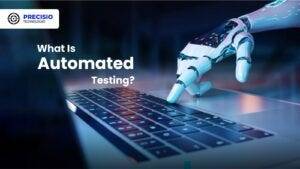
Software performing automated testing executes test cases through workflows and helpers. Key Characteristics:
Efficient for repetitive and regression testing.
Users must spend money on tools along with developing custom scripts for testing.
Reduces human error.
3. Advantages of Manual Testing

Human Intuition: Software testing professionals can detect kernels through their human cognitive ability that automated tools cannot match. The observation and evaluation of visual elements runs more efficiently through human operatives instead of advanced tools.
Flexibility: This method suits exploratory testing specifically because there are no pre-determined scripts available.
Low Initial Investment: Running this approach does not need tool purchases or applications to develop automation frameworks.
Adaptable for UI/UX Testing: Running this approach does not need tool purchases or applications to develop automation frameworks.
4. Advantages of Automated Testing
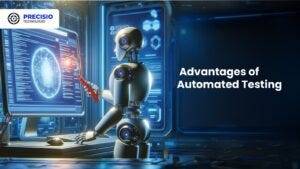
Speed: Executes repetitive tests much faster than humans.
Scalability: The system proves most effective for extensive projects that need constant system updates.
Accuracy: When performing recurring actions, automated systems minimize the chances of human mistakes.
Cost-Efficient in the Long Run: Once established and implemented, the system demands costly investments but ensures continuous development expenses decrease over time.
Better for CI/CD Pipelines: Such testing technology connects various development pipelines that support agile and DevOps methodologies.
5. Disadvantages of Manual Testing

Time-Consuming: The manual performance of repeated tests leads to delayed completion of projects.
Error-Prone: Large applications contain tiny bugs that human testers commonly fail to detect.
Not Ideal for Scalability: The process of increasing manual testing needs additional testers to avoid cost escalations.
6. Disadvantages of Automated Testing
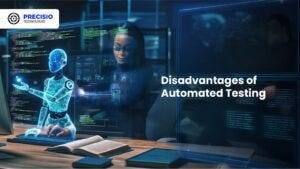
Initial Costs: Organizations must provide high financial resources to procure testing tools together with developing programming constructs.
Limited to Pre-Defined Scenarios: These testing approaches work poorly for handling exploratory or ad hoc testing.
Requires Maintenance: Test scripts need frequent updates when application changes occur.
Not Suitable for UI/UX Testing: Struggles with subjective user experience evaluations.
7. When to Use Manual Testing

Small Projects: The testing method proves beneficial at a low cost for small applications and provides quick assessments.
Exploratory Testing: Testing this approach benefits projects whose scripts have not been defined yet or need evaluation for newly added features.
Visual and Usability Testing: Performing assessments on interface components together with design features.
8. When to Use Automated Testing
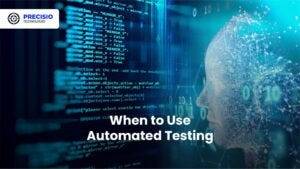
Large Projects: Handles scalability for projects with frequent updates.
Regression Testing: Program testing becomes more efficient through automation since automated assessments perform multiple tests following each update process.
Performance Testing: The system performs efficient capabilities to conduct load testing and stress testing.
Continuous Development Environments: Agile progression and DevOps implementations need automation as a core requirement.
READ MORE- https://www.precisio.tech/automated-testing-vs-manual-testing-which-one-is-right-for-your-project/
2 notes
·
View notes
Text
The DevOps Lifecycle: Building, Testing, and Deploying with Confidence
DevOps, a combination of "Development" and "Operations," has emerged as a game-changer in the software development landscape. It represents a comprehensive approach that fosters collaboration between development and operations teams, emphasizes automation, and cultivates a culture of continuous improvement. In this blog post, we will delve deeper into the world of DevOps, exploring its principles, practices, and how it works.

The Essence of DevOps:
DevOps is more than just a buzzword; it's a mindset that aims to break down silos and bridge the gap between traditionally isolated development and operations teams. At its core, DevOps promotes collaboration, automation, and a relentless focus on delivering high-quality software faster and more efficiently.
Collaboration: DevOps encourages close collaboration and communication between development and operations teams. By working together from the initial stages of a project, teams can align their goals, streamline processes, and reduce conflicts.
Automation: Automation is the backbone of DevOps. It involves using tools and scripts to automate repetitive tasks, such as code building, testing, and deployment. This not only speeds up development but also reduces the risk of human error.
The DevOps Lifecycle:
DevOps introduces a structured lifecycle that encompasses various stages, ensuring a seamless flow from code development to deployment and beyond.
Continuous Integration (CI): In this phase, developers frequently integrate their code into a shared repository. CI tools automatically build and test the code with every change, ensuring it remains functional and error-free.
Continuous Delivery (CD): Building on CI, CD automates the deployment process, allowing for the continuous delivery of tested code to production or staging environments. This enables rapid and reliable releases.
Monitoring and Feedback: DevOps teams continuously monitor applications and infrastructure in production. They collect feedback on system performance, user experience, and any issues that arise. This feedback loop is crucial for making improvements and responding to issues promptly.
Infrastructure as Code (IaC): IaC is a DevOps practice that involves managing infrastructure using code. It enables the automated provisioning, scaling, and configuration of infrastructure resources, ensuring consistency and reproducibility.
Version Control: Version control systems like Git are essential for tracking code changes, enabling collaboration, and ensuring code integrity.
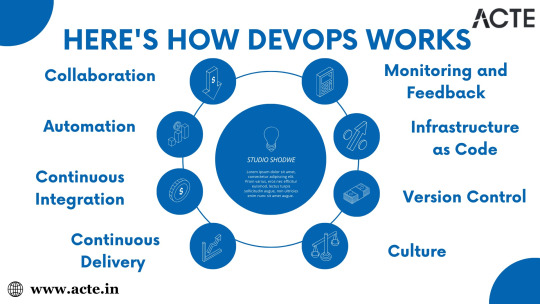
The Cultural Shift:
DevOps isn't just about tools and processes; it's also about fostering a cultural shift within an organization.
Shared Responsibility: DevOps promotes a culture of shared responsibility, where both development and operations teams take ownership of the entire software delivery process. This reduces blame-shifting and encourages problem-solving.
Accountability: DevOps encourages accountability for code quality, security, and performance. Team members are responsible for the outcomes of their work, from development to deployment.
Trust and Collaboration: Open communication and trust between teams are essential. DevOps encourages cross-functional teams to work together, breaking down traditional barriers.
DevOps is not just a trend but a transformative approach to software development and deployment. Its principles of collaboration, automation, and cultural transformation are reshaping the industry. ACTE Technologies, through its training and consulting services, plays a pivotal role in preparing professionals and organizations for success in the DevOps-driven world. Embracing DevOps and partnering with ACTE Technologies can lead to faster, more reliable software delivery and a competitive edge in today's dynamic tech landscape. Start your DevOps journey today and reap the benefits of this revolutionary approach.
19 notes
·
View notes
Text
What are the latest trends in the IT job market?

Introduction
The IT job market is changing quickly. This change is because of new technology, different employer needs, and more remote work.
For jobseekers, understanding these trends is crucial to positioning themselves as strong candidates in a highly competitive landscape.
This blog looks at the current IT job market. It offers insights into job trends and opportunities. You will also find practical strategies to improve your chances of getting your desired role.
Whether you’re in the midst of a job search or considering a career change, this guide will help you navigate the complexities of the job hunting process and secure employment in today’s market.
Section 1: Understanding the Current IT Job Market
Recent Trends in the IT Job Market
The IT sector is booming, with consistent demand for skilled professionals in various domains such as cybersecurity, cloud computing, and data science.
The COVID-19 pandemic accelerated the shift to remote work, further expanding the demand for IT roles that support this transformation.
Employers are increasingly looking for candidates with expertise in AI, machine learning, and DevOps as these technologies drive business innovation.
According to industry reports, job opportunities in IT will continue to grow, with the most substantial demand focused on software development, data analysis, and cloud architecture.
It’s essential for jobseekers to stay updated on these trends to remain competitive and tailor their skills to current market needs.
Recruitment efforts have also become more digitized, with many companies adopting virtual hiring processes and online job fairs.
This creates both challenges and opportunities for job seekers to showcase their talents and secure interviews through online platforms.
NOTE: Visit Now
Remote Work and IT
The surge in remote work opportunities has transformed the job market. Many IT companies now offer fully remote or hybrid roles, which appeal to professionals seeking greater flexibility.
While remote work has increased access to job opportunities, it has also intensified competition, as companies can now hire from a global talent pool.
Section 2: Choosing the Right Keywords for Your IT Resume
Keyword Optimization: Why It Matters
With more employers using Applicant Tracking Systems (ATS) to screen resumes, it’s essential for jobseekers to optimize their resumes with relevant keywords.
These systems scan resumes for specific words related to the job description and only advance the most relevant applications.
To increase the chances of your resume making it through the initial screening, jobseekers must identify and incorporate the right keywords into their resumes.
When searching for jobs in IT, it’s important to tailor your resume for specific job titles and responsibilities. Keywords like “software engineer,” “cloud computing,” “data security,” and “DevOps” can make a huge difference.
By strategically using keywords that reflect your skills, experience, and the job requirements, you enhance your resume’s visibility to hiring managers and recruitment software.
Step-by-Step Keyword Selection Process
Analyze Job Descriptions: Look at several job postings for roles you’re interested in and identify recurring terms.
Incorporate Specific Terms: Include technical terms related to your field (e.g., Python, Kubernetes, cloud infrastructure).
Use Action Verbs: Keywords like “developed,” “designed,” or “implemented” help demonstrate your experience in a tangible way.
Test Your Resume: Use online tools to see how well your resume aligns with specific job postings and make adjustments as necessary.
Section 3: Customizing Your Resume for Each Job Application
Why Customization is Key
One size does not fit all when it comes to resumes, especially in the IT industry. Jobseekers who customize their resumes for each job application are more likely to catch the attention of recruiters. Tailoring your resume allows you to emphasize the specific skills and experiences that align with the job description, making you a stronger candidate. Employers want to see that you’ve taken the time to understand their needs and that your expertise matches what they are looking for.
Key Areas to Customize:
Summary Section: Write a targeted summary that highlights your qualifications and goals in relation to the specific job you’re applying for.
Skills Section: Highlight the most relevant skills for the position, paying close attention to the technical requirements listed in the job posting.
Experience Section: Adjust your work experience descriptions to emphasize the accomplishments and projects that are most relevant to the job.
Education & Certifications: If certain qualifications or certifications are required, make sure they are easy to spot on your resume.
NOTE: Read More
Section 4: Reviewing and Testing Your Optimized Resume
Proofreading for Perfection
Before submitting your resume, it’s critical to review it for accuracy, clarity, and relevance. Spelling mistakes, grammatical errors, or outdated information can reflect poorly on your professionalism.
Additionally, make sure your resume is easy to read and visually organized, with clear headings and bullet points. If possible, ask a peer or mentor in the IT field to review your resume for content accuracy and feedback.
Testing Your Resume with ATS Tools
After making your resume keyword-optimized, test it using online tools that simulate ATS systems. This allows you to see how well your resume aligns with specific job descriptions and identify areas for improvement.
Many tools will give you a match score, showing you how likely your resume is to pass an ATS scan. From here, you can fine-tune your resume to increase its chances of making it to the recruiter’s desk.
Section 5: Trends Shaping the Future of IT Recruitment
Embracing Digital Recruitment
Recruiting has undergone a significant shift towards digital platforms, with job fairs, interviews, and onboarding now frequently taking place online.
This transition means that jobseekers must be comfortable navigating virtual job fairs, remote interviews, and online assessments.
As IT jobs increasingly allow remote work, companies are also using technology-driven recruitment tools like AI for screening candidates.
Jobseekers should also leverage platforms like LinkedIn to increase visibility in the recruitment space. Keeping your LinkedIn profile updated, networking with industry professionals, and engaging in online discussions can all boost your chances of being noticed by recruiters.
Furthermore, participating in virtual job fairs or IT recruitment events provides direct access to recruiters and HR professionals, enhancing your job hunt.
FAQs
1. How important are keywords in IT resumes?
Keywords are essential in IT resumes because they ensure your resume passes through Applicant Tracking Systems (ATS), which scans resumes for specific terms related to the job. Without the right keywords, your resume may not reach a human recruiter.
2. How often should I update my resume?
It’s a good idea to update your resume regularly, especially when you gain new skills or experience. Also, customize it for every job application to ensure it aligns with the job’s specific requirements.
3. What are the most in-demand IT jobs?
Some of the most in-demand IT jobs include software developers, cloud engineers, cybersecurity analysts, data scientists, and DevOps engineers.
4. How can I stand out in the current IT job market?
To stand out, jobseekers should focus on tailoring their resumes, building strong online profiles, networking, and keeping up-to-date with industry trends. Participation in online forums, attending webinars, and earning industry-relevant certifications can also enhance visibility.
Conclusion
The IT job market continues to offer exciting opportunities for jobseekers, driven by technological innovations and changing work patterns.
By staying informed about current trends, customizing your resume, using keywords effectively, and testing your optimized resume, you can improve your job search success.
Whether you are new to the IT field or an experienced professional, leveraging these strategies will help you navigate the competitive landscape and secure a job that aligns with your career goals.
NOTE: Contact Us
2 notes
·
View notes
Text
What is the importance of ai based testing?
Ai-Based Testing Services
AI - Artificial Intelligence is transforming the way software testing is done. AI-Based Testing is now a crucial part of modern software development. It brings speed, accuracy, and intelligence to testing processes that were once slow and repetitive. But why is it so important? Let's explore.
Faster Testing, Faster Releases -
Manual Testing takes time. AI-Based Tests speeds up the process by automatically generating test cases and detecting issues without constant human input. This helps businesses deliver software faster, keeping up with tight deadlines and high customer expectations.
Smarter Test Coverage -
AI can scan large amounts of data and understand complex application behavior. This allows AI-Based Testing to create better test coverage, ensuring that common and rare user scenarios are checked. As a result, software is tested more thoroughly, and fewer bugs slip through.
Reduces Human Error -
Even experienced testers can make mistakes. AI tools run tests with consistent accuracy. AI-Based Tests reduces and lowers down the number of errors by removing the guesswork and repeating tasks the same way every time. This makes Testing more reliable and builds trust in the results.
Adapts to Changes Automatically -
In traditional Testing, when software changes, testers need to rewrite scripts. With AI-Based Testing, tests can adapt on their own. AI tools and its resources can address the changes on its own in the code and update the ongoing tests accordingly by saving time and reducing the maintenance work.
Cost Efficiency -
Though setting up AI testing tools may take some investment, it saves money in the long run. Faster releases, fewer bugs, and reduced manual labor lower overall testing costs. This makes AI-Based Tests a wise financial decision for companies of all sizes.
Supports Agile and DevOps -
Modern development needs fast feedback and continuous delivery. AI-based Tests fits perfectly into Agile and DevOps environments by offering quick and reliable Testing that helps teams stay on track without delays.
AI-Based Testing is no longer just a trend—it's a must-have for businesses that want to build high-quality software quickly and stay ahead in a competitive digital world.
Trusted and expert service providers for AI-Based Testing, such as Suma Soft, IBM, Cyntexa, and Cignex, specialize in delivering innovative, automated testing solutions tailored to business needs. They offer and assist a smooth integration process with ongoing support, and AI-powered testing tools that assure strict accuracy and efficiency is maintained across all the test process. Businesses can enhance software quality, accelerate development cycles, and reduce testing efforts with their expertise. Upgrade your QA process today and unlock the full potential of intelligent automation with this simple AI-Based Testing guide!
#it services#technology#saas#software#saas development company#saas technology#digital transformation
2 notes
·
View notes
Text
Top Courses for Aspiring Developers: Elevate Your Skills and Career
Nowadays everyone wants to enhance their skills and career. Everyone wants to improve their skills and take their career forward. You want to improve their skill and take your software development career to the next level.
Today’s tech-driven world, aspiring developers are in high demand. Here’s a guide to some of the top courses designed to elevate your skills and boost your career prospects in the field of software development. Developers use web development languages to help create dynamic web pages. The most common coding languages include Javascript, Python and C. we must constantly update our skills. We should assume good skills that will take our career forward. In this article, we will suggest courses that can help to make software developers.
1. Full-Stack Web Development
This course covers everything from front-end technologies like HTML, CSS, and JavaScript to back-end development with Node.js and Express. It’s ideal for those who want to become proficient in both client and server-side programming.
2. Data Science and Machine Learning
This specialization includes courses on machine learning, data mining, and data analysis. It provides a deep dive into algorithms, statistical methods, and practical applications.
3. Cloud Computing
This course prepares you for the AWS Certified Solutions Architect exam. It covers designing distributed systems, deploying scalable applications, and working with AWS services.
4. Mobile App Development
This series of courses is designed for aspiring iOS developers. It covers Swift programming, user interface design, and app development practices.
5. Cybersecurity
This specialization covers essential cybersecurity concepts, including risk management, cryptography, and network security. It’s designed for those interested in protecting systems and data.
6. Game Development
This specialization covers game design principles, development processes, and interactive media creation. It includes courses on Unity and Unreal Engine, two of the most popular game development platforms.
7. Software Engineering
This course provides a comprehensive overview of software engineering principles, including design patterns, testing, and project management.
8. DevOps
This course introduces key DevOps concepts such as continuous integration, continuous delivery, and infrastructure as code. It’s ideal for developers looking to improve collaboration between development and operations.
By identifying the right courses and doing those courses, we can follow the path of success. As you consider the courses to take, we should do the courses in which we are interest.
Top Courses for Aspiring Developers: Elevate Your Skills and Career
Nowadays everyone wants to enhance their skills and career. Everyone wants to improve their skills and take their career forward. You want to improve their skill and take your software development career to the next level.
Today’s tech-driven world, aspiring developers are in high demand. Here’s a guide to some of the top courses designed to elevate your skills and boost your career prospects in the field of software development. Developers use web development languages to help create dynamic web pages. The most common coding languages include Javascript, Python and C. we must constantly update our skills. We should assume good skills that will take our career forward. In this article, we will suggest courses that can help to make software developers.
1. Full-Stack Web Development
This course covers everything from front-end technologies like HTML, CSS, and JavaScript to back-end development with Node.js and Express. It’s ideal for those who want to become proficient in both client and server-side programming.
2. Data Science and Machine Learning
This specialization includes courses on machine learning, data mining, and data analysis. It provides a deep dive into algorithms, statistical methods, and practical applications.
3. Cloud Computing
This course prepares you for the AWS Certified Solutions Architect exam. It covers designing distributed systems, deploying scalable applications, and working with AWS services.
4. Mobile App Development
This series of courses is designed for aspiring iOS developers. It covers Swift programming, user interface design, and app development practices.
5. Cybersecurity
This specialization covers essential cybersecurity concepts, including risk management, cryptography, and network security. It’s designed for those interested in protecting systems and data.
6. Game Development
This specialization covers game design principles, development processes, and interactive media creation. It includes courses on Unity and Unreal Engine, two of the most popular game development platforms.
7. Software Engineering
This course provides a comprehensive overview of software engineering principles, including design patterns, testing, and project management.
8. DevOps
This course introduces key DevOps concepts such as continuous integration, continuous delivery, and infrastructure as code. It’s ideal for developers looking to improve collaboration between development and operations.
By identifying the right courses and doing those courses, we can follow the path of success. As you consider the courses to take, we should do the courses in which we are interest.
2 notes
·
View notes